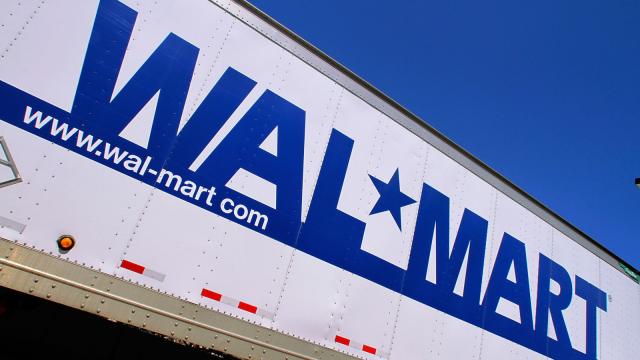Walmart has published a wide-ranging report on how the company predicts automation will unfold across the nation. Based on data supplied by the McKinsey Global Institute, the report “examines more than 3,000 counties in the United States with the goal of helping communities plan for their individual situations and develop responses that will position them to survive and thrive in a changing economy.”
This “Roadmap for Tomorrow” includes six policy recommendations, including “implementing career and technical education programs that link education with jobs,” and that the USDA should funnel investment dollars into rural businesses. Now, why would Walmart, the world’s largest retailer, partner with McKinsey, one of the world’s largest business consulting firms, produce a report aimed at making public policy recommendations around automation?
Fortunately, we don’t need to speculate — Walmart lays it out in the press release:
“The research is anchored in Walmart’s efforts to address the needs of our business, including preparing our workforce for the future. We are committed to helping strengthen the systems on which our success depends: A sustainable workforce, strong local talent development, and thriving communities with a solid customer base. Ninety per cent of Americans live within ten miles of a Walmart store.”
It might not seem so at first glance, but this is pretty remarkable: Walmart is explicitly making the case that because of its centrality to American life, governments and other institutions should invest in the conditions that will sustain and strengthen its business in the age of automation. As Walmart automates its workers out of jobs, it is arguing that the government and institutions like universities pick up the tab for retraining and supporting them, so that they might more effectively toil at the next evolution of Walmart, or at least shop at it.
Walmart is, essentially, applying for future-forward corporate welfare. Its chief goal here, unsurprisingly, is keeping Walmart widely profitable.
First things first — I’ve said it before, and I’ll say it again: Corporate reports and reports aligning with corporate interests *always* treat automation as a predetermined phenomenon; as a force of nature rather than a business decision. Here, automation is described as “reshaping work across America,” rather than as, say, “a corporate strategy we, Walmart, have embraced, along with other companies across the sector.”
Whether or not it is a strategy adopted in order to keep pace with its competition, who are also automating their workforces, Walmart is deploying automated inventory management systems, automatic self-checkout, automated mop robots, and automated product-sorting conveyor belts to its backrooms.
(It is using automation both to replace jobs outright and to help migrate more jobs to freelance contract positions and gig work.)
These are all industrial and commercial machines purchased at the behest of management, not machines that became sentient and constructed themselves according to SkyNet code.
But, if one accepts the premise that corporate automation and job displacement is pre-ordained, and one happens to be, say, a municipal government worker or mayor justifiably concerned with the employment levels of his or her town, then they might be far more likely to allocate funds for one of the six policy recommendations Walmart prescribes:
These recommendations as further detailed in the report include:
-
Obtaining federal investment in rural business development
-
Getting governments and universities to fund job retraining and re-skilling alongside corporations
-
Asking communities to pay unemployment in up-front lump sums, “mobility grants,” or providing a “small” “job-seeker’s allowance” to displaced workers, and to back “credentialing” of non-full-time (and precarious) workers.
-
Having the government build out more physical infrastructure like public transit and broadband so displaced workers can access new jobs
-
“Modernising” the social safety net by providing things like “portable benefits,” essentially a reduced version of the employee benefits currently offered to full-time employees that would be available to part-time and gig workers. (This idea is supported by gig economy giants like Uber, probably because they believe it might help them avoid having to classify workers as full-time employees and thus having to provide full benefits.)
-
Having public education institutions offer automation-friendly job training programs.
Some of these are undeniably good things that the government really should do. But understand that this is a framework through which Walmart is attempting to justify degrading the quality of its jobs, relegating more jobs to gig work, and unloading its current benefits and salary burden onto the public sphere. And it’s asking cities and states to pay for “upskilling” and retraining and much of the rest of this platform explicitly because so many Americans live near a Walmart store, and what’s good for Walmart is good for America.
Between the World Economic Forum, World Bank, and Brookings reports on automation, I’ve been dancing around this idea for a bit now, and this report is the clearest-cut case yet — in order to prepare for automation that they are instigating, corporations are asking, essentially, for government aid.
The baked-in logic here is that automation is forcing Walmart to eliminate jobs and benefits, so schools and governments should respond by helping those people continue to work and shop at Walmart — you’ll notice there’s nary a peep about extending any of the benefits of automation to the workers it’s asking the state to retrain and support. There’s no talk of shortening work days now that automation is removing some of the labour burden, or improving benefits in any way.
By portraying itself as a victim and not a perpetrator of automation, the world’s largest retailer is able to, with a straight face, demand that the government invest in its preparations for a future where it pays workers less, takes on more part-time work, and allows its fleet of machines to send ever more profits upstream.
